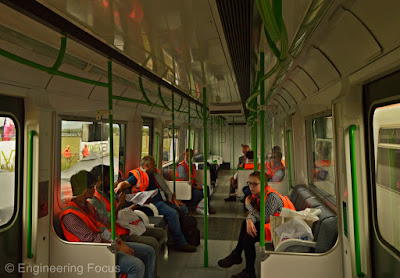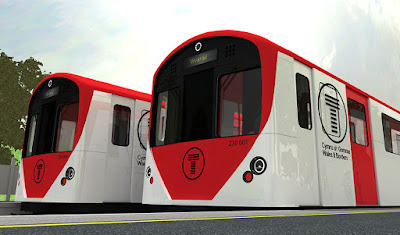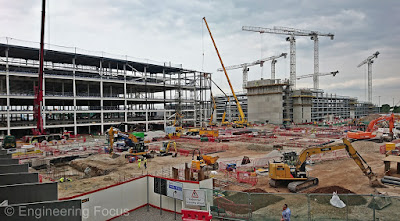Porterbrook has been developing its own bi-mode (or in fact tri-mode) units for a number of years and last year it was announced that Arriva Rail North (Northern) had ordered 8 of what were branded "Flex" trains, which now have a TOPS classification of 769
The Flex units are being converted from class 319s all which have been sent off lease from Thameslink and Southern. Some 319s were sent north to operate on recently electrified lines between Manchester, Liverpool and Preston, with the first refurbished 319 entering service between Liverpool and Manchester in 2015. However the majority of the 319s are now surplus to requirements.
769 000 already painted in Northern colours
The Flex units are being described as "Tri-mode" as they will be able to draw power from 750v DC third rail and 25kV overhead lines whilst also being able to operate under their own power on non-electrified lines.
Each 4 car train will have 2 6 cylinder diesel engines provided by MAN placed underneath each driving vehicle, the engines will be used to generate electricity to power traction motors. Each horizontal 6 cylinder engine will produce 390kw and will comply with the latest EU Stage IIIB emission standards.
It is understood that GWR will use 769s on Reading - Gatwick Airport and Reading - Oxford routes. This will allow GWR to re-deploy class 165/166s to the Bristol area.
Each 4 car train will have 2 6 cylinder diesel engines provided by MAN placed underneath each driving vehicle, the engines will be used to generate electricity to power traction motors. Each horizontal 6 cylinder engine will produce 390kw and will comply with the latest EU Stage IIIB emission standards.
The horizontal 6 cylinder 13 Litre engine provided by MAN
Since the initial order of 8 units for Northern was confirmed a further 24 units have been ordered, 19 for Great Western Railway and 5 for Arriva Trains Wales. The 5 units originally ordered by ATW were destined for South Wales and despite the announcement that KeolisAmey will take over the Wales and Borders franchise the current plans do not seem to have changed.
5 years ago it was thought that demand for diesel multiple units (DMUs) would decrease rapidly and that the routes on which the class 796s will operate would be electrified. But with cancellations and delays to electrification schemes the rail industry found itself with a potential shortage of rolling stock and crucially DMUs.
Whilst it is true to say that train operating companies have suffered from a shortage of DMUs for a number of years, the problems facing the rail industry over the next 1 to 3 year could have been much worse. With public pressure to remove Pacers from service completely, electrification woes and new disability standards which mean many DMUs will have to be modified by 2020 to comply with PRM TSI standards all having an affect on the availability of units.
That is if companies such as Porterbrook and Vivarail hadn't spotted the potential problems facing the industry and decided to take a risk and invest in developing solutions which could be deployed relatively quickly and were cost-effective in the short to medium term.
The class 769s and 230s will allow class 15Xs to be sent off lease to be modified to comply with PRM TSI standards and will fill a gap left by the delays and cancellation of electrification schemes. Both trains will be able to operate on electrified and non-electrified lines so no services will have to terminate where electrification ends or mean that DMUs are running for long periods along sections of railway that have been electrified.
It is hoped that passengers will see the benefits of these new units within the next 12 months and I'm fairly certain they will not notice that they will be riding on upcycled trains.
There was a huge amount to see at year's RailLive organised by Rail magazine so I have a number of posts planned covering innovation and technology. This year in particular there seemed to be a lot of innovative products on display and brand new never before seen technology. So if you follow Engineering Focus on social media or click the "subscribe by e-mail" link you won't miss out on any of the latest content over the next week.













